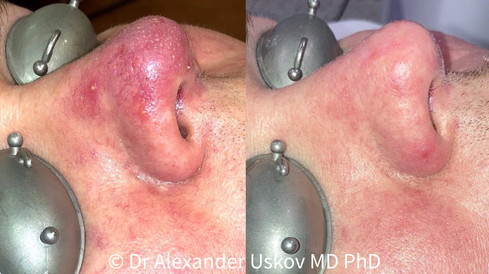Laser treatment for rosacea
- gertnulk
- Aug 17
- 3 min read
A modern solution to chronic vascular problems at Dr. Uskov’s Clinic

Rosacea is a chronic inflammatory skin condition that manifests as redness, dilated capillaries, a sensation of burning or sensitivity, flare-ups, and sometimes papulopustular eruptions.
It’s not just an aesthetic issue
Rosacea has a serious impact on quality of life, self-esteem, and emotional well-being. Many patients feel compelled to hide their skin under layers of makeup, avoid an active lifestyle, hot drinks, saunas, sun exposure, and certain foods.
Modern laser medicine makes it possible to effectively manage the vascular component of rosacea, reduce persistent redness, eliminate visible capillary “networks,” and significantly improve the appearance and condition of the skin. At the clinic of international expert Dr. Uskov, we use personalized laser treatment protocols based on international scientific data and over 15 years of practical experience.
It is important to understand that full treatment of rosacea must be comprehensive, involving cooperation between multiple specialists, including dermatologists and cosmetologists.

Relevance of the problem
According to the European Society of Dermatologists, rosacea affects 10–15% of adult patients, most often women with fair and sensitive skin, but it can also occur in men and in later adulthood.
In the past, rosacea was considered an incurable condition that one simply had to “accept.” Today, the approach is different: -rosacea can be effectively controlled -skin quality can be improved -vascular manifestations can be eliminated
Symptoms we work with:
persistent redness (erythema) of the cheeks, nose, chin, forehead
telangiectasias — visible dilated capillaries
sensitivity, burning, or a sensation of heat
redness that does not subside after rest
secondary complications — pigmentation and skin thickening.
Course of treatment
Before starting treatment, a thorough diagnostic evaluation is carried out:
visual assessment of the severity of the vascular component
digital dermatoscopy (to determine vessel diameter and depth)
UV-light and infrared imaging (to assess hidden vessels)
evaluation of accompanying skin conditions, since rosacea may coexist with seborrhea, demodicosis, or acne.
Based on these findings, Dr. Uskov develops a personalized treatment protocol and selects the optimal laser parameters.
Which lasers do we use?
Our clinic uses all recommended wavelengths to target different depths and vessel types:
IPL (515–640 nm): for diffuse erythema and telangiectasias
Nd:YAG (1064 nm): for deeper vessels and larger capillaries
KTP (532 nm): for superficial, fine capillaries on the cheeks and nose
Picosecond and fractional lasers: as part of combination protocols when pigmentation, thickening, or post-inflammatory changes are present
How many sessions does it take?
To achieve a noticeable and lasting effect, a course of 2–4 sessions spaced 3–12 weeks apart is usually required.
After just the first session, most patients report:
reduced redness
lightening of vascular networks
a more even skin tone
lower skin reactivity to temperature, food, and cosmetics
The outcome depends on:
severity of the vascular component
diameter and depth of capillaries
patient’s age and skin phototype
stage of rosacea
adherence to post-treatment recommendations
How is laser treatment safe and effective?
The action is precise and selective — it targets only the vessels without damaging surrounding tissues.
Modern devices are equipped with cooling systems, making the procedure comfortable and safe.
Treatments are performed by physicians with specialized laser training.
At Dr. Uskov’s clinic, only certified, medical-grade laser systems are used.
Individualized approach
Everyones skin is unique. At our clinic:
we select the exact energy and wavelength for each case
we combine methods (laser, skincare, mesotherapy, photoprotection)
we provide personalized home-care and relapse prevention recommendations
we monitor progress with photos and dermatoscopy before and after treatment
Clinical “before & after” photos available on our website allow you to clearly see the results across different cases.
We treat patients of all ages
We welcome:
teenagers with early-stage erythema
women with combined forms of rosacea
men with phymatous rosacea (including rhinophyma)
elderly patients with chronic manifestations
Modern techniques allow us to control rosacea and restore a healthy, even skin tone.
























